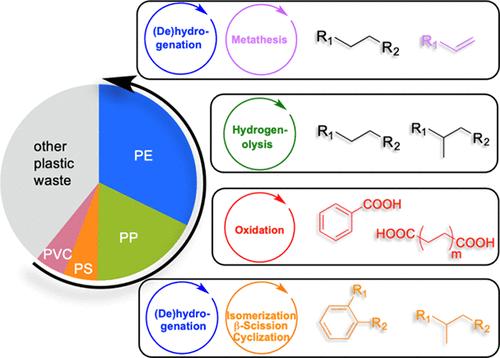当前位置:
X-MOL 学术
›
Chem. Rev.
›
论文详情
Our official English website, www.x-mol.net, welcomes your
feedback! (Note: you will need to create a separate account there.)
Catalytic Upcycling of Polyolefins
Chemical Reviews ( IF 51.4 ) Pub Date : 2024-08-16 , DOI: 10.1021/acs.chemrev.3c00943 Jiakai Sun 1 , Jinhu Dong 2 , Lijun Gao 2 , Yu-Quan Zhao 1 , Hyunjin Moon 2 , Susannah L Scott 1, 2
Chemical Reviews ( IF 51.4 ) Pub Date : 2024-08-16 , DOI: 10.1021/acs.chemrev.3c00943 Jiakai Sun 1 , Jinhu Dong 2 , Lijun Gao 2 , Yu-Quan Zhao 1 , Hyunjin Moon 2 , Susannah L Scott 1, 2
Affiliation

|
The large production volumes of commodity polyolefins (specifically, polyethylene, polypropylene, polystyrene, and poly(vinyl chloride)), in conjunction with their low unit values and multitude of short-term uses, have resulted in a significant and pressing waste management challenge. Only a small fraction of these polyolefins is currently mechanically recycled, with the rest being incinerated, accumulating in landfills, or leaking into the natural environment. Since polyolefins are energy-rich materials, there is considerable interest in recouping some of their chemical value while simultaneously motivating more responsible end-of-life management. An emerging strategy is catalytic depolymerization, in which a portion of the C–C bonds in the polyolefin backbone is broken with the assistance of a catalyst and, in some cases, additional small molecule reagents. When the products are small molecules or materials with higher value in their own right, or as chemical feedstocks, the process is called upcycling. This review summarizes recent progress for four major catalytic upcycling strategies: hydrogenolysis, (hydro)cracking, tandem processes involving metathesis, and selective oxidation. Key considerations include macromolecular reaction mechanisms relative to small molecule mechanisms, catalyst design for macromolecular transformations, and the effect of process conditions on product selectivity. Metrics for describing polyolefin upcycling are critically evaluated, and an outlook for future advances is described.
中文翻译:

聚烯烃的催化升级循环
商品聚烯烃(特别是聚乙烯、聚丙烯、聚苯乙烯和聚氯乙烯)的大量生产,加上其单位价值较低和短期用途广泛,导致废物管理面临重大而紧迫的挑战。目前,这些聚烯烃中只有一小部分被机械回收,其余的则被焚烧、堆积在垃圾填埋场或泄漏到自然环境中。由于聚烯烃是能源丰富的材料,因此人们对回收其部分化学价值同时激发更负责任的报废管理非常感兴趣。一种新兴的策略是催化解聚,其中聚烯烃主链中的部分 C-C 键在催化剂的帮助下断裂,在某些情况下还需要额外的小分子试剂。当产品是小分子或本身具有较高价值的材料或作为化学原料时,该过程称为升级回收。本综述总结了四种主要催化升级回收策略的最新进展:氢解、(加氢)裂化、涉及复分解的串联过程和选择性氧化。关键考虑因素包括相对于小分子机制的大分子反应机制、大分子转化的催化剂设计以及工艺条件对产物选择性的影响。对描述聚烯烃升级循环的指标进行了严格评估,并描述了未来进展的前景。
更新日期:2024-08-16
中文翻译:

聚烯烃的催化升级循环
商品聚烯烃(特别是聚乙烯、聚丙烯、聚苯乙烯和聚氯乙烯)的大量生产,加上其单位价值较低和短期用途广泛,导致废物管理面临重大而紧迫的挑战。目前,这些聚烯烃中只有一小部分被机械回收,其余的则被焚烧、堆积在垃圾填埋场或泄漏到自然环境中。由于聚烯烃是能源丰富的材料,因此人们对回收其部分化学价值同时激发更负责任的报废管理非常感兴趣。一种新兴的策略是催化解聚,其中聚烯烃主链中的部分 C-C 键在催化剂的帮助下断裂,在某些情况下还需要额外的小分子试剂。当产品是小分子或本身具有较高价值的材料或作为化学原料时,该过程称为升级回收。本综述总结了四种主要催化升级回收策略的最新进展:氢解、(加氢)裂化、涉及复分解的串联过程和选择性氧化。关键考虑因素包括相对于小分子机制的大分子反应机制、大分子转化的催化剂设计以及工艺条件对产物选择性的影响。对描述聚烯烃升级循环的指标进行了严格评估,并描述了未来进展的前景。


















































 京公网安备 11010802027423号
京公网安备 11010802027423号